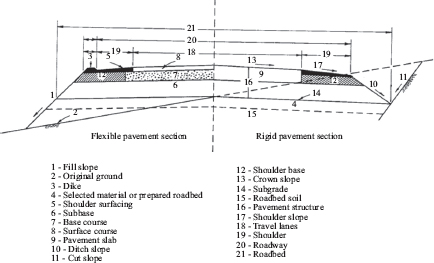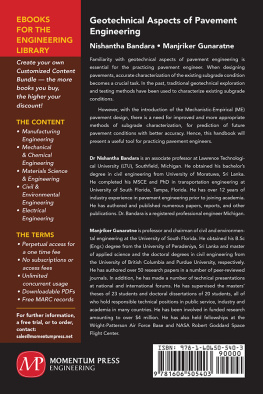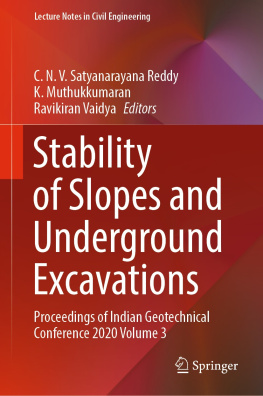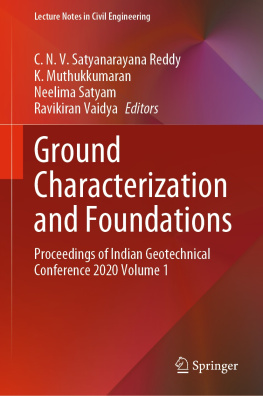Bandara Nishanta - Geotechnical aspects of pavement engineering
Here you can read online Bandara Nishanta - Geotechnical aspects of pavement engineering full text of the book (entire story) in english for free. Download pdf and epub, get meaning, cover and reviews about this ebook. year: 2018, publisher: Momentum Press, genre: Children. Description of the work, (preface) as well as reviews are available. Best literature library LitArk.com created for fans of good reading and offers a wide selection of genres:
Romance novel
Science fiction
Adventure
Detective
Science
History
Home and family
Prose
Art
Politics
Computer
Non-fiction
Religion
Business
Children
Humor
Choose a favorite category and find really read worthwhile books. Enjoy immersion in the world of imagination, feel the emotions of the characters or learn something new for yourself, make an fascinating discovery.
- Book:Geotechnical aspects of pavement engineering
- Author:
- Publisher:Momentum Press
- Genre:
- Year:2018
- Rating:5 / 5
- Favourites:Add to favourites
- Your mark:
- 100
- 1
- 2
- 3
- 4
- 5
Geotechnical aspects of pavement engineering: summary, description and annotation
We offer to read an annotation, description, summary or preface (depends on what the author of the book "Geotechnical aspects of pavement engineering" wrote himself). If you haven't found the necessary information about the book — write in the comments, we will try to find it.
Geotechnical aspects of pavement engineering — read online for free the complete book (whole text) full work
Below is the text of the book, divided by pages. System saving the place of the last page read, allows you to conveniently read the book "Geotechnical aspects of pavement engineering" online for free, without having to search again every time where you left off. Put a bookmark, and you can go to the page where you finished reading at any time.
Font size:
Interval:
Bookmark:

GEOTECHNICAL ASPECTS OF PAVEMENT ENGINEERING
GEOTECHNICAL ASPECTS OF PAVEMENT ENGINEERING
NISHANTHA BANDARA AND MANJRIKER GUNARATNE

Geotechnical Aspects of Pavement Engineering
Copyright Momentum Press, LLC, 2018.
All rights reserved. No part of this publication may be reproduced, stored in a retrieval system, or transmitted in any form or by any meanselectronic, mechanical, photocopy, recording, or any otherexcept for brief quotations, not to exceed 400 words, without the prior permission of the publisher.
First published by Momentum Press, LLC
222 East 46th Street, New York, NY 10017
www.momentumpress.net
ISBN-13: 978-1-60650-540-3 (print)
ISBN-13: 978-1-60650-541-0 (e-book)
Momentum Press Geotechnical Engineering Collection
Collection ISSN: 2376-4945 (print)
Collection ISSN: 2376-4953 (electronic)
Cover and interior design by Exeter Premedia Services Private Ltd., Chennai, India
10 9 8 7 6 5 4 3 2 1
Printed in the United States of America
ABSTRACT
Familiarity with geotechnical aspects of pavement engineering is essential for any practicing pavement or geotechnical engineer. When designing pavements on an existing roadbed or along a new alignment, accurate characterization of the existing subgrade condition plays an important and difficult task. In most situations, traditional geotechnical exploration and testing methods have been used to characterize the existing subgrade conditions. However, with the introduction of new Mechanistic-Empirical (ME) pavement design methods, there is a need for improved and more appropriate methods to characterize the exiting subgrade materials in order to predict future pavement conditions with better accuracy. Hence this handbook will be quite useful for practicing pavement engineers in terms of selecting proper field testing methods, characterizing subgrade materials, selecting proper pavement design, and treatment methods for unusual field conditions, and thus for effective construction of pavement foundations in general.
This book introduces field exploration and testing methods from low-cost alternatives to accurate and efficient start-of-the-art methods. Another important feature of this book is the inclusion of an entire chapter devoted to dealing with unusual field conditions encountered in practice at times. This particular chapter provides design details and treatment guidelines to address such difficulties.
This book is a valuable resource for any practicing pavement engineer or a civil engineering student who wishes to pursue a career in highway design and construction.
KEYWORDS
construction, design, exploration, mechanistic, pavement, subgrade, testing
CONTENTS
).
With the introduction of the Mechanistic-Empirical Pavement Design (MEPD) procedures, an emphasis on collecting reliable material property data has been seen in the recent past. This is due to the fact that, when properly calibrated performance models are used by specifying accurate material inputs, realistic pavement performance predictions can be obtained from the MEPD procedures. The majority of materials used above the subgrade of a pavement structure are engineered in nature, and hence they could be produced to specifications and tested for accurate material properties. However, in situ subgrade materials show considerable variability from point to point in terms of its engineering properties. Therefore, accurate and easy-to-use methods to characterize pavement subgrade properties have been gaining popularity in the recent past.
Geotechnical aspects of pavement engineering are different from traditional geotechnical engineering due to the marked differences in loading mechanisms associated with highway pavements. Traditional geotechnical engineering generally deals with static, concentrated, or distributed, large-magnitude loading conditions, while pavement structures mostly deal with fast-moving and dynamic loading situations. Furthermore, effects of environmental and climatic conditions play a major role in pavement structures due to their proximity and the constant exposure to the atmosphere.
The objective of this introductory chapter is to provide an overview to the subject matter covered in the book. The components of a pavement system, types of pavement, and the historical evolution of design are briefly introduced in the following sections.
1.1 THE PAVEMENT SYSTEM
The pavement system consists of distinct layers of materials placed on the subgrade, including select materials, subbase, base, and a surface course, as shown in . The subgrade of the pavement system includes natural ground prepared either by mechanically compacting, stabilizing, or building with select borrow fill materials to create a platform for the construction of upper pavement layers. However, as the subgrade acts as the foundation for the entire pavement structure, proper evaluation of the subgrade materials and close supervision of its construction is important for future pavement performance. Important parameters other than the stiffness of the subgrade material include depth to bedrock or hard layers and seasonal fluctuation of the ground water table.
Pavement subbases generally consist of free draining granular materials. Water seeping through cracks and joints on the pavement surface will penetrate to the subbase through the base course. Granular material in the subbase layer is expected to remove this infiltrated water rapidly to underdrains or roadside ditches. Removal of water from the base and subbase is essential for the durability of pavements. The pavement structures will be weakened by any water retained within base and subbase and lead to premature failure. Furthermore, in areas with cold weather, water retained within the base and subbase can freeze during winter months and heave the pavement structure. During the ensuing spring time, due to the melting of ice within the base or subbase, voids open up under the pavement structure. In addition, the subbase works as a protecting layer for frost-susceptible subgrade material in cold weather areas.

Figure 1.1. Components of a pavement system (NCHRP 2004).
Pavement bases generally consist of freely drainable crushed aggregates, crushed rocks, gravel, slag, crushed concrete, and so on. Typically, better materials are used for the base layer than the subbase. Also, material specification for the base layer is more stringent than for the materials for subbase layer. For flexible pavements, the base layer provides the majority of the structural support, while for rigid pavements, it provides the stiffness needed by the foundation. The base layer also facilitates water drainage from the pavement structure and also protects the frost-susceptible subgrade during winter months in colder climate areas.
The pavement surface course is designed to withstand the impact of traffic loads during the design life of the pavement and provide a smooth ride for the traveling public while assuring adequate skid resistance for safe travel at all times. Pavement surface courses can be made out of one or more layers of asphaltic materials for flexible pavements and Portland cement concrete for rigid pavements. Most of the major highways built with flexible pavements are constructed with hot-mix asphalt (HMA) materials. HMA generally consists of asphalt binder, coarse aggregate, fine aggregate, and other additives mixed at a higher temperature in an asphalt plant. These materials are transported to the project site and laid at higher temperatures. Some low-volume roads are constructed with asphalt emulsion mixed with aggregates at the ambient temperature. Rigid pavements are constructed with Portland cement concrete (PCC) with or without steel reinforcements. If no steel reinforcements are used, they generally consist of joints at regular intervals and are called jointed plain concrete pavements (JPCP). Reinforced concrete pavements can be categorized into two types, jointed reinforced concrete pavements (JRCP) and continuously reinforced concrete pavements (CRCP). As the names suggest, JRCP has joints at regular intervals, and CRCP only contains construction joints. Some very low-volume roads can be constructed with compacted aggregate, gravel, or soil, and they are known as unpaved roads.
Next pageFont size:
Interval:
Bookmark:
Similar books «Geotechnical aspects of pavement engineering»
Look at similar books to Geotechnical aspects of pavement engineering. We have selected literature similar in name and meaning in the hope of providing readers with more options to find new, interesting, not yet read works.
Discussion, reviews of the book Geotechnical aspects of pavement engineering and just readers' own opinions. Leave your comments, write what you think about the work, its meaning or the main characters. Specify what exactly you liked and what you didn't like, and why you think so.







